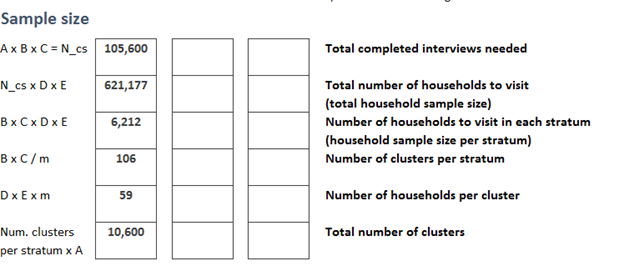Haditya L Mukri’s Updates
Week 2 assignment
A. Number of strata (N_strata): 100 (same as total districts)
B. Effective sample size (ESS): 264
Expected coverage: 0.85
Desired precision (half width of CI): 0.05
Alpha (α): 0.05
C. Design effect (DEFF): 4
Intracluster correlation coefficient (ICC): 0.33
D. Average number of households to visit to find 1 eligible respondent: 5
E. Non-response inflation factor: 1.176
Response rate: 0.85
Total completed interviews needed: 105,600
Total number of households to visit (total household sample visits): 621,177
Number of Households to visit in each stratum (household sample size per stratum): 6,212
Number of clusters per stratum: 106
Number of households per cluster: 59
Total number of clusters: 10,600
Q1. The overall sample size = 105,600
Q2. How many households would have to be visited = 621,177
Q3. What do you think of this estimated sample size?
With the population of 22million, the Harmonia would conduct survey around 621,177 household to find 105,600 children. The stratum in districts is 6,212 with number of cluster per stratus 106 and 59 housholds per cluster and with total 10,600 cluster. The effort to reach the target is quite difficult and need more consideration.
Q4. How feasible will it be to conduct this survey?
Would be a challenged to conduct the survey, for my personnal comment it would better to conduct after the sensus to get more acurate and best results.
Q5. What are the trade-offs in terms of time, money, and quality of survey implementation?
To conduct a survey capturing coverage data at this time would spend a lot of time and money but the quality would get better if conduct the survey after the sensus.


